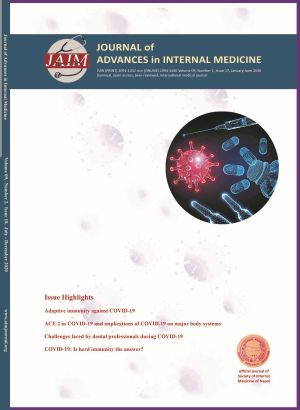Angiotensin Converting Enzyme 2 in COVID-19 infections and the implications of COVID-19 on major body systems
DOI:
https://doi.org/10.3126/jaim.v9i2.32604Keywords:
Covid-19, coronavirus, SARS-CoV-2 virus, renin angiotensin system, angiotensin coverting enzyme-2Abstract
COVID-19, caused by the severe acute respiratory syndrome coronavirus (SARS-CoV-2), was first identified in China in late 2019 and since then, this disease has become a pandemic affecting many countries across the globe. Due to this outbreak, many researchers have been diligently investigating this disease for the establishment of better methods of its treatment and control. Evidence from research has led to a plethora of valuable but uncertain information on the modes of transmission of COVID-19 and the mechanisms by which SARS-CoV-2 establishes infections in targeted tissues. It is now better understood that in this disease, SARS-CoV-2 gains entrance into cells by specifically binding ACE-2 (angiotensin-converting enzyme 2); ACE-2 serves as a potential receptor for the virus. The lungs, in addition to many other organs and tissues, express ACE-2 in varying degrees. Therefore, this review will examine the role of ACE-2 in COVID-19 and the secondary effects that COVID-19 has on organs that express ACE-2. To this end, it will assist in establishing the relationship between the ACE-2 receptor and SARS-CoV-2, bringing to the forefront the correlation between the symptomatology presentation, as well as the severity of infections experienced with COVID-19. Given this, it may even provide an avenue for the generation of treatment, or create a platform for the enhanced knowledge of this novel virus, and therefore, control, and maybe unravel the mystery for long term complications.
Downloads
Downloads
Published
How to Cite
Issue
Section
License
This license enables reusers to distribute, remix, adapt, and build upon the material in any medium or format, so long as attribution is given to the creator.




